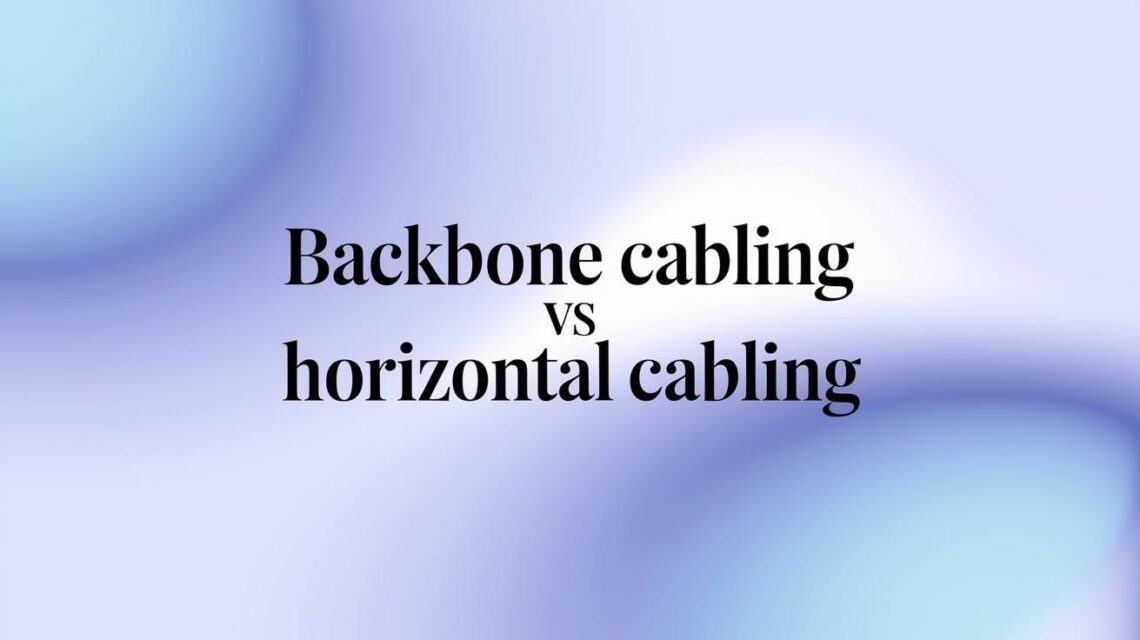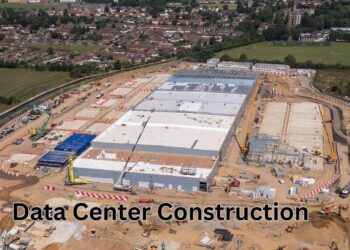After installing backbone cables in over 200 buildings during my 15 years as a network engineer, I’ve learned that most people get confused about how the internet reaches different floors.
Last month, I repaired a 20-story office building where someone had attempted to use regular horizontal cables between floors. The result? Slow internet on floors 5 through 20 and frustrated workers calling IT every hour.
A vertically installed cable that serves as the backbone of a building’s multi-floor network is what makes these networks work. I’ve seen buildings fail because owners didn’t understand this basic difference.
This guide comes from real projects I’ve completed, following industry standards from TIA-568-C and BICSI guidelines that I’m certified in. You’ll get proven methods that work in actual buildings, not just theory from textbooks.
What Is an Up and Down Backbone Cable?
An up and down cable that serves as the backbone cable between floors of a building is also called intra-building backbone cabling. This type of cable runs up and down through your building like a highway for data.
The main job of backbone cables is to link gear rooms and telecom closets on different floors. Think of it as the main road that connects smaller neighborhood streets. These cables make sure all floors can talk to each other.
Companies use backbone cables for high-capacity, long-distance data sending inside buildings. They can handle much more data than regular cables and work well over longer distances between floors.
Backbone vs Flat Cabling: Key Differences
Understanding the differences between backbone and flat cabling is crucial for any building network setup. These two cable types serve completely different purposes and have distinct technical specs that determine where and how you use them.
| Feature | Backbone Cabling | Flat Cabling |
| Purpose | Connects floors, buildings, and major network points | Connects telecom rooms to single workstations |
| Function | Act as main highways for data traffic | Works like local roads, bringing the network to desks |
| Physical Setup | Runs up and down between floors | Spreads flat across single floors |
| Pathways | Goes through risers, conduits, elevator shafts | Runs through ceiling tiles, under floors, along walls |
| Cable Types | Fiber optic or high-pair copper | Twisted pair copper (Cat5e/Cat6) |
| Distance Limits | Can handle long runs between floors | Limited to 90 meters maximum |
| Speed Capacity | High-speed, high-capacity data sending | Standard desktop speeds |
| Cost | More expensive but handles more data | Less expensive for basic needs |
| Fire Rating | Must meet strict plenum/riser ratings | Standard ratings for single-floor use |
| Installation | Needs special structural support | Easier to install and modify |
The backbone system moves data between floors while flat cables spread it within each floor. Both types work together but serve very different jobs in your overall network setup. Choosing the wrong type can lead to poor network results and costly fixes later.
Components of a Backbone Cabling System
A backbone cabling system includes several important parts that work together to move data between floors.
Cable Pathways
Buildings need proper pathways for backbone cables to travel between floors safely. Conduits protect cables from damage and provide organized routing. Risers are up and down spaces made just for cable runs.
Floor sleeves allow cables to pass through concrete floors without damage. Raceways provide added safety and order for cable bundles as they move through the building.
Connecting Hardware
Patch panels organize and terminate backbone cables in gear rooms. Cross-connects allow network managers to change links without rewiring. Connecting blocks provide secure ending points for copper cables.
These hardware pieces let technicians test, maintain, and modify the backbone system. Good connecting hardware makes fixing problems much easier when issues occur.
Cable Media
Fiber optic cables offer the highest results for backbone uses. Coaxial cables work well for certain backbone needs like video sharing. Twisted pair copper cables can handle backbone jobs in smaller buildings.
The choice of cable media depends on distance, speed needs, and budget. Most modern backbone systems use fiber optic for the best results and future growth.
Support Setup
Firestopping materials seal cable openings to prevent fire spread between floors. Grounding systems protect gear and people from electrical problems. Cable trays provide strong support for heavy backbone cable bundles.
Proper support setup keeps the backbone system safe and legal. Building codes require specific fire and safety measures for up and down cable setups.
Types of Backbone Cabling Based on Setup Area
Different buildings need different types of backbone cabling depending on their size and layout.
Intra Building Backbone
Intra-building backbone cables make up and down runs between floors in the same building. An up-and-down cable that serves as the backbone cable between floors of a building fits this category perfectly. These cables stay within one structure and connect different levels.
Most office buildings use an intra-building backbone for their main network links. The cables run from the basement gear rooms up to telecom closets on each floor.
Inter Building Backbone
Inter-building backbone creates underground or overhead links between separate buildings on the same property. These cables cross parking lots, courtyards, or streets to connect different structures. Campus settings often need this type of backbone link.
Weather safety becomes very important for inter-building backbone cables. Underground setup protects cables but costs more than overhead runs.
Campus Backbone
Campus backbone handles larger-scale links across multi-building sites like universities or corporate campuses. These systems connect many buildings across large areas. The backbone network becomes more complex with multiple link points.
Campus backbone often uses high-grade fiber optic cables for long distances. Network design must account for future growth and changing building uses.
Setup Considerations for Up and Down Backbone Cables
Setting up backbone cables between floors needs careful planning and attention to building rules.
Backbone cable installation faces special challenges compared to horizontal cabling. The vertical nature means dealing with gravity, building codes, and structural issues. Fire safety becomes critical when cables cross between floors.
Key setup factors include:
- Strong structural support systems to handle cable weight over multiple floors
- Strict fire rating compliance to meet building safety codes
- Climate controls in gear rooms to protect sensitive network gear
- Underground routing options for campus links
- Growth planning for future cable additions
Proper setup ensures the backbone system works reliably for many years. Poor setup can cause network problems and safety issues. Building codes exist to protect people and property from cable-related hazards.
Network Topologies Where Backbone Cabling is Used
Different network designs use backbone cabling in various ways to connect building floors and gear.
Distributed Backbone
Spread backbone creates multiple link points throughout the building for better network control. Each floor or section gets its link to the main backbone. This design allows network managers to handle different building areas separately.
Network problems in one area don’t affect other sections as much. The spread approach costs more but provides better results and fixing options.
Collapsed Backbone
Collapsed backbone uses one central hub to connect all building areas. All backbone links come together at a single point, usually in the main gear room. This design is simple and costs less than spread systems.
The main risk is having a single point of failure that could affect the entire building. If the central hub fails, the whole network goes down.
Parallel Backbone
A parallel backbone provides backup links for fault tolerance and backup safety. Two or more backbone paths connect the same endpoints. If one backbone cable fails, traffic automatically switches to the backup path.
This design costs more but prevents network outages from cable problems. Critical buildings like hospitals often use a parallel backbone for dependability.
Serial Backbone
A serial backbone uses a basic, daisy-chained structure where each floor connects to the next in sequence. This design costs the least but offers minimal protection against failures. One broken link can affect multiple floors downstream.
Small buildings with limited budgets sometimes use a serial backbone. The simple design makes setup and upkeep easier for basic network needs.
Choosing Between Backbone and Horizontal Cabling for Your Building
The choice between backbone and horizontal cabling depends on your specific building layout and network needs.
Scale determines which cable type you need: floor-to-floor connections require backbone cables, while same-floor connections use horizontal cabling.
A vertically installed cable that serves as the backbone cable between floors of a building handles the vertical connections between different levels.
Use backbone cabling when your network needs inter-floor talk or central gear rooms. Buildings with server rooms in basements and user areas on upper floors need backbone links. The backbone system brings network services from central locations to each floor.
Always check cabling standards like TIA-568 to make sure your setup meets industry rules. These standards specify cable types, distances, and setup methods for different uses. Following standards ensures your network will work properly and support future upgrades.
Conclusion
From my experience working on backbone systems in hospitals, schools, and corporate towers, I can tell you that a vertically installed cable that serves as the backbone cable between floors of a building makes or breaks your network performance.
I’ve watched IT teams waste thousands of dollars using the wrong cable types, then call me to fix the mess.
The difference between backbone and horizontal cabling isn’t just technical talk. It’s about choosing cables that actually work for your building size and layout.
I follow NECA/BICSI standards in every installation because they prevent the problems I used to see in poorly planned networks.
As a certified network designer, I recommend planning for growth and always using proper backbone cables between floors. Your future self will thank you when your network keeps running smoothly for decades.
Frequently Asked Questions
Is vertical cabling the same as backbone cabling?
Yes, vertical cabling and backbone cabling often refer to the same thing. A vertically installed cable that serves as the backbone cable between floors of a building is both vertical and backbone cabling. The terms describe cables that run up and down between floors to connect different levels of a building.
Can horizontal cabling be used vertically?
No, horizontal cables should not be used for vertical runs between floors. Horizontal cables have distance limits of 90 meters and lack the fire ratings required for vertical installations. They also can’t handle the weight and stress of vertical mounting over multiple floors.
What fire safety concerns apply to vertical cabling?
Up and down cables must meet strict fire ratings because they can spread fire between floors. Building codes need plenum-rated or riser-rated cables, depending on the setup area. Firestopping materials must seal all floor openings to prevent fire spread through cable pathways.
What’s the best cable type for vertical installations?
Fiber optic cables work best for most up and down backbone setups. They handle long distances, high speeds, and don’t suffer from electrical noise. For shorter runs or budget setups, high-pair copper cables can work, but have more limits.
How long can a horizontal cable run before needing backbone support?
Flat cables can run up to 90 meters before needing backbone support. Beyond this distance, signal quality gets worse and network results suffer. Buildings with longer flat runs need middle gear rooms connected by backbone cables.








